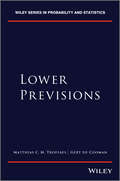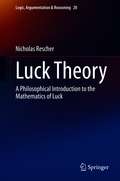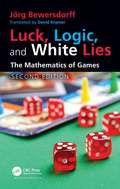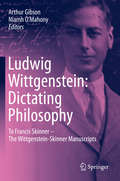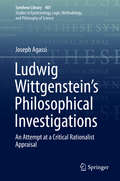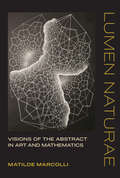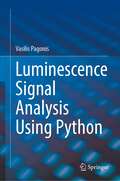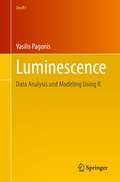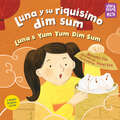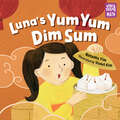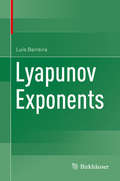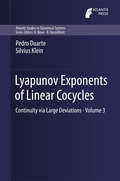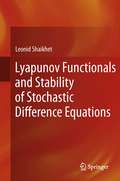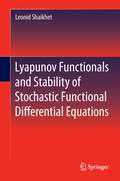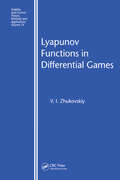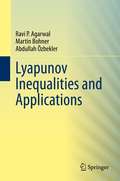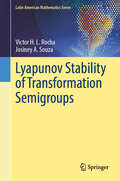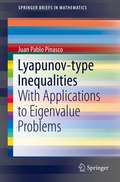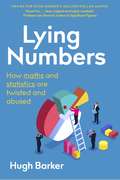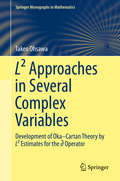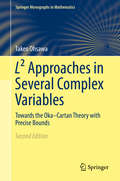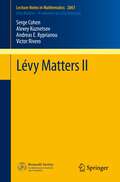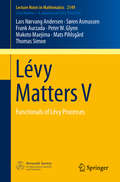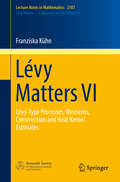- Table View
- List View
Lower Previsions
by Gert De Cooman Matthias C. TroffaesThis book has two main purposes. On the one hand, it provides aconcise and systematic development of the theory of lower previsions,based on the concept of acceptability, in spirit of the work ofWilliams and Walley. On the other hand, it also extends this theory todeal with unbounded quantities, which abound in practicalapplications.Following Williams, we start out with sets of acceptable gambles. Fromthose, we derive rationality criteria---avoiding sure loss andcoherence---and inference methods---natural extension---for(unconditional) lower previsions. We then proceed to study variousaspects of the resulting theory, including the concept of expectation(linear previsions), limits, vacuous models, classical propositionallogic, lower oscillations, and monotone convergence. We discussn-monotonicity for lower previsions, and relate lower previsions withChoquet integration, belief functions, random sets, possibilitymeasures, various integrals, symmetry, and representation theoremsbased on the Bishop-De Leeuw theorem.Next, we extend the framework of sets of acceptable gambles to consideralso unbounded quantities. As before, we again derive rationalitycriteria and inference methods for lower previsions, this time alsoallowing for conditioning. We apply this theory to constructextensions of lower previsions from bounded random quantities to alarger set of random quantities, based on ideas borrowed from thetheory of Dunford integration.A first step is to extend a lower prevision to random quantities thatare bounded on the complement of a null set (essentially boundedrandom quantities). This extension is achieved by a natural extensionprocedure that can be motivated by a rationality axiom stating thatadding null random quantities does not affect acceptability.In a further step, we approximate unbounded random quantities by asequences of bounded ones, and, in essence, we identify those forwhich the induced lower prevision limit does not depend on the detailsof the approximation. We call those random quantities 'previsible'. Westudy previsibility by cut sequences, and arrive at a simplesufficient condition. For the 2-monotone case, we establish a Choquetintegral representation for the extension. For the general case, weprove that the extension can always be written as an envelope ofDunford integrals. We end with some examples of the theory.
Luck Theory: A Philosophical Introduction to the Mathematics of Luck (Logic, Argumentation & Reasoning #20)
by Nicholas RescherThis book is an original—the first-ever treatment of the mathematics of Luck. Setting out from the principle that luck can be measured by the gap between reasonable expectation and eventual realization, the book develops step-by-step a mathematical theory that accommodates the entire range of our pre-systematic understanding of the way in which luck functions in human affairs. In so moving from explanatory exposition to mathematical treatment, the book provides a clear and accessible account of the way in which luck assessment enters into the calculations of rational decision theory.
Luck, Logic, and White Lies: The Mathematics of Games
by Jörg BewersdorffPraise for the Second Edition "Luck, Logic, and White Lies teaches readers of all backgrounds about the insight mathematical knowledge can bring and is highly recommended reading among avid game players, both to better understand the game itself and to improve one’s skills." – Midwest Book Review "The best book I've found for someone new to game math is Luck, Logic and White Lies by Jörg Bewersdorff. It introduces the reader to a vast mathematical literature, and does so in an enormously clear manner. . ." – Alfred Wallace, Musings, Ramblings, and Things Left Unsaid "The aim is to introduce the mathematics that will allow analysis of the problem or game. This is done in gentle stages, from chapter to chapter, so as to reach as broad an audience as possible . . . Anyone who likes games and has a taste for analytical thinking will enjoy this book." – Peter Fillmore, CMS Notes Luck, Logic, and White Lies: The Mathematics of Games, Second Edition considers a specific problem—generally a game or game fragment and introduces the related mathematical methods. It contains a section on the historical development of the theories of games of chance, and combinatorial and strategic games. This new edition features new and much refreshed chapters, including an all-new Part IV on the problem of how to measure skill in games. Readers are also introduced to new references and techniques developed since the previous edition. Features Provides a uniquely historical perspective on the mathematical underpinnings of a comprehensive list of games Suitable for a broad audience of differing mathematical levels. Anyone with a passion for games, game theory, and mathematics will enjoy this book, whether they be students, academics, or game enthusiasts Covers a wide selection of topics at a level that can be appreciated on a historical, recreational, and mathematical level. Jörg Bewersdorff (1958) studied mathematics from 1975 to 1982 at the University of Bonn and earned his PhD in 1985. In the same year, he started his career as game developer and mathematician. He served as the general manager of the subsidiaries of Gauselmann AG for more than two decades where he developed electronic gaming machines, automatic payment machines, and coin-operated Internet terminals. Dr. Bewersdorff has authored several books on Galois theory (translated in English and Korean), mathematical statistics, and object-oriented programming with JavaScript.
Ludwig Wittgenstein: To Francis Skinner – The Wittgenstein-Skinner Manuscripts
by Ludwig Wittgenstein Francis SkinnerIn this volume we witness Wittgenstein in the act of composing and experimenting with his new visions in philosophy. The book includes key explanations of the origin and background of these previously unknown manuscripts. It investigates how Wittgenstein’s philosophical thought-processes are revealed in his dictation to, as well as his editing and revision with Francis Skinner, in the latter’s role of amanuensis. The book displays a considerable wealth and variety of Wittgenstein’s fundamental experiments in philosophy across a wide array of subjects that include the mind, pure and applied mathematics, metaphysics, the identities of ordinary and creative language, as well as intractable problems in logic and life. He also periodically engages with the work of Newton, Fermat, Russell and others. The book shows Wittgenstein strongly battling against the limits of understanding and the bewitchment of institutional and linguistic customs. The reader is drawn in by Wittgenstein as he urges us to join him in his struggles to equip us with skills, so that we can embark on devising new pathways beyond confusion. This collection of manuscripts was posted off by Wittgenstein to be considered for publication during World War 2, in October 1941. None of it was published and it remained hidden for over two generations. Upon its rediscovery, Professor Gibson was invited to research, prepare and edit the Archive to appear as this book, encouraged by Trinity College Cambridge and The Mathematical Association. Niamh O’Mahony joined him in co-editing and bringing this book to publication.
Ludwig Wittgenstein’s Philosophical Investigations: An Attempt at a Critical Rationalist Appraisal (Synthese Library #401)
by Joseph AgassiThis book collects 13 papers that explore Wittgenstein's philosophy throughout the different stages of his career. The author writes from the viewpoint of critical rationalism. The tone of his analysis is friendly and appreciative yet critical. Of these papers, seven are on the background to the philosophy of Wittgenstein. Five papers examine different aspects of it: one on the philosophy of young Wittgenstein, one on his transitional period, and the final three on the philosophy of mature Wittgenstein, chiefly his Philosophical Investigations. The last of these papers, which serves as the concluding chapter, concerns the analytical school of philosophy that grew chiefly under its influence. Wittgenstein’s posthumous Philosophical Investigations ignores formal languages while retaining the view of metaphysics as meaningless -- declaring that all languages are metaphysics-free. It was very popular in the middle of the twentieth century. Now it is passé. Wittgenstein had hoped to dissolve all philosophical disputes, yet he generated a new kind of dispute. His claim to have improved the philosophy of life is awkward just because he prevented philosophical discussion from the ability to achieve that: he cut the branch on which he was sitting. This, according to the author, is the most serious critique of Wittgenstein.
Lumen Naturae: Visions of the Abstract in Art and Mathematics
by Matilde MarcolliExploring common themes in modern art, mathematics, and science, including the concept of space, the notion of randomness, and the shape of the cosmos.This is a book about art—and a book about mathematics and physics. In Lumen Naturae (the title refers to a purely immanent, non-supernatural form of enlightenment), mathematical physicist Matilde Marcolli explores common themes in modern art and modern science—the concept of space, the notion of randomness, the shape of the cosmos, and other puzzles of the universe—while mapping convergences with the work of such artists as Paul Cezanne, Mark Rothko, Sol LeWitt, and Lee Krasner. Her account, focusing on questions she has investigated in her own scientific work, is illustrated by more than two hundred color images of artworks by modern and contemporary artists. Thus Marcolli finds in still life paintings broad and deep philosophical reflections on space and time, and connects notions of space in mathematics to works by Paul Klee, Salvador Dalí, and others. She considers the relation of entropy and art and how notions of entropy have been expressed by such artists as Hans Arp and Fernand Léger; and traces the evolution of randomness as a mode of artistic expression. She analyzes the relation between graphical illustration and scientific text, and offers her own watercolor-decorated mathematical notebooks. Throughout, she balances discussions of science with explorations of art, using one to inform the other. (She employs some formal notation, which can easily be skipped by general readers.) Marcolli is not simply explaining art to scientists and science to artists; she charts unexpected interdependencies that illuminate the universe.
Luminescence Signal Analysis Using Python
by Vasilis PagonisThis book compiles and presents a complete package of open-access Python software code for luminescence signal analysis in the areas of radiation dosimetry, luminescence dosimetry, and luminescence dating. Featuring more than 90 detailed worked examples of Python code, fully integrated into the text, 16 chapters summarize the theory and equations behind the subject matter, while presenting the practical Python codes used to analyze experimental data and extract the various parameters that mathematically describe the luminescence signals. Several examples are provided of how researchers can use and modify the available codes for different practical situations. Types of luminescence signals analyzed in the book are thermoluminescence (TL), isothermal luminescence (ITL), optically stimulated luminescence (OSL), infrared stimulated luminescence (IRSL), timeresolved luminescence (TR) and dose response of dosimetric materials. The open-access Python codes are available at GitHub.The book is well suited to the broader scientific audience using the tools of luminescence dosimetry: physicists, geologists, archaeologists, solid-state physicists, medical physicists, and all scientists using luminescence dosimetry in their research. The detailed code provided allows both students and researchers to be trained quickly and efficiently on the practical aspects of their work, while also providing an overview of the theory behind the analytical equations.
Luminescence: Data Analysis and Modeling Using R (Use R!)
by Vasilis PagonisThis book covers applications of R to the general discipline of radiation dosimetry and to the specific areas of luminescence dosimetry, luminescence dating, and radiation protection dosimetry. It features more than 90 detailed worked examples of R code fully integrated into the text, with extensive annotations. The book shows how researchers can use available R packages to analyze their experimental data, and how to extract the various parameters describing mathematically the luminescence signals. In each chapter, the theory behind the subject is summarized, and references are given from the literature, so that researchers can look up the details of the theory and the relevant experiments. Several chapters are dedicated to Monte Carlo methods, which are used to simulate the luminescence processes during the irradiation, heating, and optical stimulation of solids, for a wide variety of materials. This book will be useful to those who use the tools of luminescence dosimetry, including physicists, geologists, archaeologists, and for all researchers who use radiation in their research.
Luna y su riquísimo dim sum / Luna's Yum Yum Dim Sum (Storytelling Math)
by Natasha Yim¡Celebremos la diversidad, las matemáticas y el poder del cuento! Celebrate diversity, math, and the power of storytelling with this bilingual (Spanish and English) edition!¡Ahora en edición bilingüe inglés-español! El día de su cumpleaños, Luna y su familia salen a comer dim sum, pero Luna y sus hermanos no se ponen de acuerdo para compartir los panecillos de puerco de manera justa. ¿Cómo se pueden dividir cinco panecillos entre tres personas?¿Alguno de los hermanos debería comer más que los otros? ¿O deberían cortar los panecillos en trozos muy pequeñitos para que todos coman la misma cantidad? Esta es una entretenida exploración sobre división y fracciones entre personajes chinoamericanos con notas culturales. On Luna's birthday, the whole family goes out for dim sum--but Luna and her brothers can't agree on how to share their pork buns fairly. How can three people divide up five buns? A playful exploration of division and fractions, featuring Chinese American characters and a cultural note.Storytelling Math celebrates children using math in their daily adventures as they play, build, and discover the world around them. Developed in collaboration with math experts at STEM education nonprofit TERC, under a grant from the Heising-Simons Foundation.
Luna's Yum Yum Dim Sum (Storytelling Math)
by Natasha YimCelebrate diversity, math, and the power of storytelling!On Luna's birthday, the whole family goes out for dim sum--but Luna and her brothers can't agree on how to share their pork buns fairly. How can three people divide up five buns? Should some siblings get more than others? Or should they cut the buns into smaller and smaller pieces so everyone gets the same amount? A playful exploration of division and fractions, featuring Chinese American characters and a cultural note.Storytelling Math celebrates children using math in their daily adventures as they play, build, and discover the world around them. Joyful stories and hands-on activities make it easy for kids and their grown-ups to explore everyday math together. Developed in collaboration with math experts at STEM education nonprofit TERC, under a grant from the Heising-Simons Foundation.
Lyapunov Exponents
by Luís BarreiraThis book offers a self-contained introduction to the theory of Lyapunov exponents and its applications, mainly in connection with hyperbolicity, ergodic theory and multifractal analysis. It discusses the foundations and some of the main results and main techniques in the area, while also highlighting selected topics of current research interest. With the exception of a few basic results from ergodic theory and the thermodynamic formalism, all the results presented include detailed proofs. The book is intended for all researchers and graduate students specializing in dynamical systems who are looking for a comprehensive overview of the foundations of the theory and a sample of its applications.
Lyapunov Exponents of Linear Cocycles
by Pedro Duarte Silvius KleinThe aim of this monograph is to present a general method of proving continuity of Lyapunov exponents of linear cocycles. The method uses an inductive procedure based on a general, geometric version of the Avalanche Principle. The main assumption required by this method is the availability of appropriate large deviation type estimates for quantities related to the iterates of the base and fiber dynamics associated with the linear cocycle. We establish such estimates for various models of random and quasi-periodic cocycles. Our method has its origins in a paper of M. Goldstein and W. Schlag. Our present work expands upon their approach in both depth and breadth. We conclude this monograph with a list of related open problems, some of which may be treated using a similar approach.
Lyapunov Functionals and Stability of Stochastic Difference Equations
by Leonid ShaikhetHereditary systems (or systems with either delay or after-effects) are widely used to model processes in physics, mechanics, control, economics and biology. An important element in their study is their stability. Stability conditions for difference equations with delay can be obtained using a Lyapunov functional. Lyapunov Functionals and Stability of Stochastic Difference Equations describes a general method of Lyapunov functional construction to investigate the stability of discrete- and continuous-time stochastic Volterra difference equations. The method allows the investigation of the degree to which the stability properties of differential equations are preserved in their difference analogues. The text is self-contained, beginning with basic definitions and the mathematical fundamentals of Lyapunov functional construction and moving on from particular to general stability results for stochastic difference equations with constant coefficients. Results are then discussed for stochastic difference equations of linear, nonlinear, delayed, discrete and continuous types. Examples are drawn from a variety of physical systems including inverted pendulum control, study of epidemic development, Nicholson's blowflies equation and predator-prey relationships. Lyapunov Functionals and Stability of Stochastic Difference Equations is primarily addressed to experts in stability theory but will also be of use in the work of pure and computational mathematicians and researchers using the ideas of optimal control to study economic, mechanical and biological systems.
Lyapunov Functionals and Stability of Stochastic Functional Differential Equations
by Leonid ShaikhetStability conditions for functional differential equations can be obtained using Lyapunov functionals. Lyapunov Functionals and Stability of Stochastic Functional Differential Equations describes the general method of construction of Lyapunov functionals to investigate the stability of differential equations with delays. This work continues and complements the author's previous book Lyapunov Functionals and Stability of Stochastic Difference Equations, where this method is described for difference equations with discrete and continuous time. The text begins with both a description and a delineation of the peculiarities of deterministic and stochastic functional differential equations. There follows basic definitions for stability theory of stochastic hereditary systems, and the formal procedure of Lyapunov functionals construction is presented. Stability investigation is conducted for stochastic linear and nonlinear differential equations with constant and distributed delays. The proposed method is used for stability investigation of different mathematical models such as: * inverted controlled pendulum; * Nicholson's blowflies equation; * predator-prey relationships; * epidemic development; and * mathematical models that describe human behaviours related to addictions and obesity. Lyapunov Functionals and Stability of Stochastic Functional Differential Equations is primarily addressed to experts in stability theory but will also be of interest to professionals and students in pure and computational mathematics, physics, engineering, medicine, and biology.
Lyapunov Functions in Differential Games (Stability and Control: Theory, Methods and Applications)
by Vladislav I ZhukovskiyA major step in differential games is determining an explicit form of the strategies of players who follow a certain optimality principle. To do this, the associated modification of Bellman dynamic programming problems has to be solved; for some differential games this could be Lyapunov functions whose "arsenal" has been supplied by stability theor
Lyapunov Inequalities and Applications
by Ravi P. Agarwal Martin Bohner Abdullah ÖzbeklerThis book provides an extensive survey on Lyapunov-type inequalities. It summarizes and puts order into a vast literature available on the subject, and sketches recent developments in this topic. In an elegant and didactic way, this work presents the concepts underlying Lyapunov-type inequalities, covering how they developed and what kind of problems they address. This survey starts by introducing basic applications of Lyapunov’s inequalities. It then advances towards even-order, odd-order, and higher-order boundary value problems; Lyapunov and Hartman-type inequalities; systems of linear, nonlinear, and quasi-linear differential equations; recent developments in Lyapunov-type inequalities; partial differential equations; linear difference equations; and Lyapunov-type inequalities for linear, half-linear, and nonlinear dynamic equations on time scales, as well as linear Hamiltonian dynamic systems. Senior undergraduate students and graduate students of mathematics, engineering, and science will benefit most from this book, as well as researchers in the areas of ordinary differential equations, partial differential equations, difference equations, and dynamic equations. Some background in calculus, ordinary and partial differential equations, and difference equations is recommended for full enjoyment of the content.
Lyapunov Stability of Transformation Semigroups (Latin American Mathematics Series)
by Victor H. Rocha Josiney A. SouzaThis book presents recent research results on Lyapunov stability and attraction for semigroup actions in a pedagogical format, providing the reader with numerous modern ideas and mathematical formulations for dynamical concepts in the transformation group theory. In recent decades, many fundamental concepts of dynamical systems have been extended to the general framework of transformation semigroups. Limit sets, attractors, isolated invariant sets, prolongational limit sets, and stable sets now have semigroup theoretical analogues. This monograph consolidates recent advancements in this field in a way that makes it accessible to graduate students. An effort was made to relate the presented results to important recurrence notions, for contextual clarity. A rudimentary understanding of group theory and topology, including the concepts of semigroup action, orbit, fiber bundle, compactness, and connectedness, is a prerequisite for reading this text. As a valuable resource for research projects and academic dissertations on topological dynamics, geometry, and mathematical analysis, this work can potentially open new avenues for further research.
Lyapunov-type Inequalities
by Juan Pablo PinascoThe eigenvalue problems for quasilinear and nonlinear operators present many differences with the linear case, and a Lyapunov inequality for quasilinear resonant systems showed the existence of eigenvalue asymptotics driven by the coupling of the equations instead of the order of the equations. For p=2, the coupling and the order of the equations are the same, so this cannot happen in linear problems. Another striking difference between linear and quasilinear second order differential operators is the existence of Lyapunov-type inequalities in R^n when p>n. Since the linear case corresponds to p=2, for the usual Laplacian there exists a Lyapunov inequality only for one-dimensional problems. For linear higher order problems, several Lyapunov-type inequalities were found by Egorov and Kondratiev and collected in On spectral theory of elliptic operators, Birkhauser Basel 1996. However, there exists an interesting interplay between the dimension of the underlying space, the order of the differential operator, the Sobolev space where the operator is defined, and the norm of the weight appearing in the inequality which is not fully developed. Also, the Lyapunov inequality for differential equations in Orlicz spaces can be used to develop an oscillation theory, bypassing the classical sturmian theory which is not known yet for those equations. For more general operators, like the p(x) laplacian, the possibility of existence of Lyapunov-type inequalities remains unexplored.
Lying Numbers: How Maths and Statistics Are Twisted and Abused
by Hugh BarkerA readily understandable exploration of how figures are badly reported or deliberately misrepresented everywhere from political arguments and briefings to business presentations and shopping offers.Praise for Hugh Barker's Million Dollar Maths:'Great fun. A clear, original and highly readable account of the curious relationship between mathematics and money.' Professor Ian Stewart - author of Significant Figures'A lively crash course in the mathematics of gambling, investing, and managing. Hugh Barker makes deep ideas fun and profitable.' William Poundstone - author of How to Predict the UnpredictablePoliticians, economists, scientists, journalists . . . all of them have been known to bend the truth and to twist the facts from time to time. But surely the numbers and statistics they rely on are cold, hard objective facts that tell the real story? Of course the truth is much murkier than that. Figures can be misinterpreted, misunderstood, misconstrued and misused in hundreds of different ways. This book takes a look at the many ways that statistical information can be badly reported or deliberately misused in all walks of life, from political arguments, to business presentations, to more local concerns such as shopping offers and utility bills. A polemical guide to how numbers are used to mislead, which is intended to help the reader through the minefield of dubious stats and lying numbers.
Lying Numbers: How Maths and Statistics Are Twisted and Abused
by Pocket Book of R Hugh BarkerA readily understandable exploration of how figures are badly reported or deliberately misrepresented everywhere from political arguments and briefings to business presentations and shopping offers.Praise for Hugh Barker's Million Dollar Maths:'Great fun. A clear, original and highly readable account of the curious relationship between mathematics and money.' Professor Ian Stewart - author of Significant Figures'A lively crash course in the mathematics of gambling, investing, and managing. Hugh Barker makes deep ideas fun and profitable.' William Poundstone - author of How to Predict the Unpredictable Politicians, economists, scientists, journalists . . . all of them have been known to bend the truth and to twist the facts from time to time. But surely the numbers and statistics they rely on are cold, hard objective facts that tell the real story? Of course the truth is much murkier than that. Figures can be misinterpreted, misunderstood, misconstrued and misused in hundreds of different ways. This book takes a look at the many ways that statistical information can be badly reported or deliberately misused in all walks of life, from political arguments, to business presentations, to more local concerns such as shopping offers and utility bills. A polemical guide to how numbers are used to mislead, which is intended to help the reader through the minefield of dubious stats and lying numbers.
L² Approaches in Several Complex Variables
by Takeo OhsawaThe purpose of this monograph is to present the current status of a rapidly developing part of several complex variables, motivated by the applicability of effective results to algebraic geometry and differential geometry. Highlighted are the new precise results on the L² extension of holomorphic functions. In Chapter 1, the classical questions of several complex variables motivating the development of this field are reviewed after necessary preparations from the basic notions of those variables and of complex manifolds such as holomorphic functions, pseudoconvexity, differential forms, and cohomology. In Chapter 2, the L² method of solving the d-bar equation is presented emphasizing its differential geometric aspect. In Chapter 3, a refinement of the Oka-Cartan theory is given by this method. The L² extension theorem with an optimal constant is included, obtained recently by Z. BÅ,ocki and by Q. -A. Guan and X. -Y. Zhou separately. In Chapter 4, various results on the Bergman kernel are presented, including recent works of Maitani-Yamaguchi, Berndtsson, and Guan-Zhou. Most of these results are obtained by the L² method. In the last chapter, rather specific results are discussed on the existence and classification of certain holomorphic foliations and Levi flat hypersurfaces as their stables sets. These are also applications of the L² method obtained during these 15 years.
L² Approaches in Several Complex Variables: Towards the Oka–Cartan Theory with Precise Bounds (Springer Monographs in Mathematics)
by Takeo OhsawaThis monograph presents the current status of a rapidly developing part of several complex variables, motivated by the applicability of effective results to algebraic geometry and differential geometry. Special emphasis is put on the new precise results on the L² extension of holomorphic functions in the past 5 years.In Chapter 1, the classical questions of several complex variables motivating the development of this field are reviewed after necessary preparations from the basic notions of those variables and of complex manifolds such as holomorphic functions, pseudoconvexity, differential forms, and cohomology. In Chapter 2, the L² method of solving the d-bar equation is presented emphasizing its differential geometric aspect. In Chapter 3, a refinement of the Oka–Cartan theory is given by this method. The L² extension theorem with an optimal constant is included, obtained recently by Z. Błocki and separately by Q.-A. Guan and X.-Y. Zhou. In Chapter 4, various results on the Bergman kernel are presented, including recent works of Maitani–Yamaguchi, Berndtsson, Guan–Zhou, and Berndtsson–Lempert. Most of these results are obtained by the L² method. In the last chapter, rather specific results are discussed on the existence and classification of certain holomorphic foliations and Levi flat hypersurfaces as their stables sets. These are also applications of the L² method obtained during the past 15 years.
Lévy Matters II
by Victor Rivero Alexey Kuznetsov Serge Cohen Andreas KyprianouThis is the second volume in a subseries of the Lecture Notes in Mathematics called Lévy Matters, which is published at irregular intervals over the years. Each volume examines a number of key topics in the theory or applications of Lévy processes and pays tribute to the state of the art of this rapidly evolving subject with special emphasis on the non-Brownian world. The expository articles in this second volume cover two important topics in the area of Lévy processes. The first article by Serge Cohen reviews the most important findings on fractional Lévy fields to date in a self-contained piece, offering a theoretical introduction as well as possible applications and simulation techniques. The second article, by Alexey Kuznetsov, Andreas E. Kyprianou, and Victor Rivero, presents an up to date account of the theory and application of scale functions for spectrally negative Lévy processes, including an extensive numerical overview.
Lévy Matters V
by Makoto Maejima Lars Nørvang Andersen Søren Asmussen Frank Aurzada Peter W. Glynn Mats Pihlsgård Thomas SimonThis three-chapter volume concerns the distributions of certain functionals of Lévy processes. The first chapter, by Makoto Maejima, surveys representations of the main sub-classes of infinitesimal distributions in terms of mappings of certain Lévy processes via stochastic integration. The second chapter, by Lars Nørvang Andersen, Søren Asmussen, Peter W. Glynn and Mats Pihlsgård, concerns Lévy processes reflected at two barriers, where reflection is formulated à la Skorokhod. These processes can be used to model systems with a finite capacity, which is crucial in many real life situations, a most important quantity being the overflow or the loss occurring at the upper barrier. If a process is killed when crossing the boundary, a natural question concerns its lifetime. Deep formulas from fluctuation theory are the key to many classical results, which are reviewed in the third chapter by Frank Aurzada and Thomas Simon. The main part, however, discusses recent advances and developments in the setting where the process is given either by the partial sum of a random walk or the integral of a Lévy process.
Lévy Matters VI
by Franziska KühnPresenting some recent results on the construction and the moments of Lévy-type processes, the focus of this volume is on a new existence theorem, which is proved using a parametrix construction. Applications range from heat kernel estimates for a class of Lévy-type processes to existence and uniqueness theorems for Lévy-driven stochastic differential equations with Hölder continuous coefficients. Moreover, necessary and sufficient conditions for the existence of moments of Lévy-type processes are studied and some estimates on moments are derived. Lévy-type processes behave locally like Lévy processes but, in contrast to Lévy processes, they are not homogeneous in space. Typical examples are processes with varying index of stability and solutions of Lévy-driven stochastic differential equations.This is the sixth volume in a subseries of the Lecture Notes in Mathematics called Lévy Matters. Each volume describes a number of important topics in the theory or applications of Lévy processes and pays tribute to the state of the art of this rapidly evolving subject, with special emphasis on the non-Brownian world.
